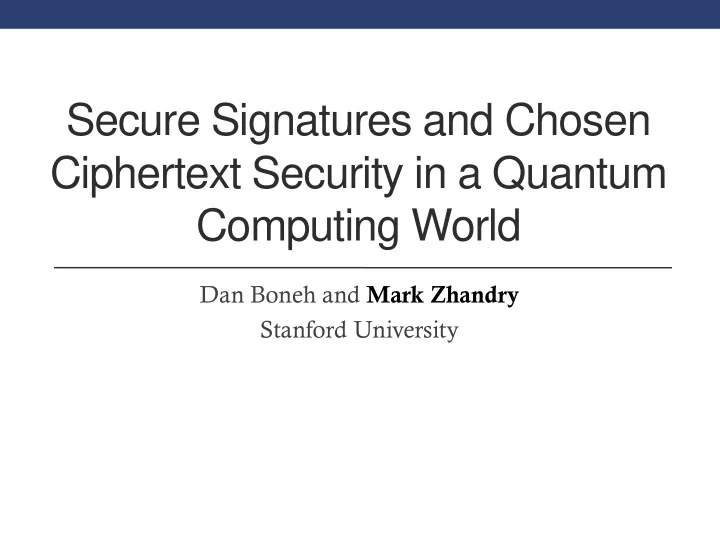

Secure Signatures and Chosen Ciphertext Security in a Quantum Computing World Dan Boneh and Mark Zhandry Stanford University
Classical Chosen Message Attack (CMA) m σ = S(sk, m) signing key sk
Classical CMA + Quantum Computer (post-quantum CMA) Adversary has quantum computing power: m σ = S(sk, m) signing key sk Interactions remain classical ⇒ classical proofs often carry through
This Talk: Quantum CMA Everyone is quantum ⇒ quantum queries Superposition of all messages m σ signing key sk Signatures on all messages Quantum interactions ⇒ need quantum proofs Extends [ BDFLSZ ’ 11, DFNS ’ 11, Z ’ 12a, Z ’ 12b, BZ ’ 13a ]
An Emerging Field Many classical security games have quantum analogs: • Quantum secret sharing, zero knowledge [ DFNS ’ 11 ] • Quantum-secure PRFs [ Z ’ 12b ] • Quantum CMA for MACs [ BZ ’ 13a ] • Quantum-secure non-malleable commitments ??? • Quantum-secure IBE, ABE, FE ??? • Quantum-secure identification protocols ???
Motivation Quantum world ⇒ unforeseen exotic attacks? • Use most conservative model Objection: can always “ classicalize ” queries m m • Burden on hardware designer • What if adversary can bypass? Quantum-secure crypto: no need to classicalize
Quantum Security: Signature Definition m σ q queries signing key sk (m 0 , σ 0 ), …, (m q , σ q ) Existential forgery: q quantum queries ⇒ q+1 (distinct) signatures
Building Quantum-Secure Signatures Separation: Theorem: ∃ classical CMA secure schemes that are not quantum CMA secure Difficulties in proving quantum security: • Aborts seem problematic • Reduction must sign entire superposition correctly • Existing proof techniques [ Z ’ 12b, BZ ’ 13a ] leave query intact • Known limitations in quantum setting: • MPC [ DFNS ’ 11 ] • Fiat-Shamir in QROM [ DFG ’ 13 ] • Cannot prove security for unique signatures (Ex: Lamport)
Building Quantum-Secure Signatures First attempt: do classical constructions work? Examples: • From lattices [ CHKP ’ 10, ABB ’ 10 ] • Using random oracles [ BR ’ 93, GPV ’ 08 ] • From generic assumptions [ Rom ’ 90 ] Short answer: sometimes yes, with small modifications
Hash and Sign Many classical signature schemes hash before signing: sk S h V S ’ σ H m Classical Advantages: • Only sign small hash more efficient • Weak security requirements for S ’ if H modeled as random oracle Our Goal: • Prove quantum security of S assuming only classical security of S ’
Quantum Security of Hash and Sign sk h V S ’ H σ m Success prob: (m 0 , σ 0 ), …, (m q , σ q ) ε First Step: Simulate using only classical queries to S ’ Problem: exponentially many h must query S ’ too many times
Small Range Distributions [ Z ’ 12b ] Quantum simulation tool: Let P: M [r] , Q: [r] H be random functions i m h P Q ? m H h Theorem [ Z ’ 12b ]: Q ○ P ≈ H for large enough (polynomial) r
Step 1: Use S.R. Distribution for H sk i h V S ’ P Q σ m Success prob: (m 0 , σ 0 ), …, (m q , σ q ) ε/2 Now S ’ only queried on r inputs Can simulate Next Step: Use one of the σ i as a forgery for S ’ Problem: # of sigs ( q+1 ) << # of S’ queries ( r )
Intermediate Measurement New quantum simulation technique: x Success prob: in out y σ t possible outcomes x x in out y Theorem: Success prob: ≥ σ/t
Step 2: Measure Output of P sk i i h V S ’ P Q σ m Success prob: (m 0 , σ 0 ), …, (m q , σ q ) ε/2r q Only q queries to S ’ One of the σ i must be forgery for S ’ Success probability non-negligible for constant q
Many-time Secure Scheme To sign each message, draw • A random salt • A pairwise indep function R sk S V h S ’ salt σ, salt H $ m r R Theorem: If S ’ is classical many-time secure, then S is quantum many-time secure
Other Signature Constructions Theorem: (Slight variant of) GPV is quantum-secure • Uses entirely different techniques Non-Random Oracle Schemes: Theorem: Generic conversion using Chameleon hash Theorem: Collision resistance ⇒ quantum-secure signatures • Follow-up work: signatures from one-way functions
Quantum Chosen Ciphertext Attack What if adversary can learn decryptions of superpositions of ciphertexts? c m decryption key sk Adversary attempts to break classical semantic security
Quantum CCA Encryption Our results: Separation: Theorem: ∃ classical CCA secure schemes that are not quantum CCA secure Two constructions: Theorem: OWF ⇒ Symmetric key quantum CCA Theorem: LWE ⇒ Public key quantum CCA
Summary & Open Problems Classical security does not imply quantum security Quantum-secure signatures: • In the (quantum) random oracle model (inc. GPV sigs) • Using a chameleon hash • From collision resistance Quantum CCA encryption: both symmetric and public key Open Problems: • Quantum security of Fiat Shamir signatures? • Quantum security of CBC-MAC, NMAC, PMAC?
Thanks!
Recommend
More recommend